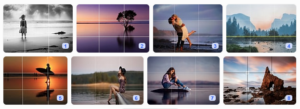 Artificial intelligence (AI) has been making a significant impact on many industries, including photography. With the advancement of AI, photography has become more accessible and efficient, allowing photographers to create high-quality images without the need for extensive knowledge or experience.
Artificial intelligence (AI) has been making a significant impact on many industries, including photography. With the advancement of AI, photography has become more accessible and efficient, allowing photographers to create high-quality images without the need for extensive knowledge or experience.
One of the most significant impacts of AI on photography is the ability to enhance images. AI algorithms can analyze an image and automatically adjust the color, brightness, contrast, and other elements to create a better-looking photo. This technology has become increasingly prevalent in photo editing software, making it easier for photographers to produce high-quality images in a short amount of time.
Another significant impact of AI on photography is its ability to automate certain tasks. For instance, some cameras have AI-powered features that can recognize different scenes and automatically adjust the camera settings to produce the best possible shot. This technology has made it easier for amateur photographers to capture high-quality images without the need for extensive knowledge or experience.
However, as with any technology, there are some possible drawbacks to the use of AI in photography. One of the most significant concerns is the potential for AI to replace human photographers. As AI continues to develop, it may become possible for machines to create high-quality images that rival or even surpass those produced by human photographers. This could lead to a decline in demand for human photographers and may ultimately lead to job losses in the industry.
Another potential drawback of AI in photography is the possibility of overreliance on technology. As AI algorithms become more prevalent in photo editing software, photographers may become too reliant on them and lose sight of the importance of creativity and personal style in photography. This could lead to a homogenization of the photography industry, with all images looking similar and lacking in originality.
Furthermore, there are concerns about the ethical implications of using AI in photography. For instance, AI algorithms can be used to manipulate images, which could lead to a rise in the production of fake or misleading images. This could have significant implications for the credibility of the photography industry and could erode public trust in the media.
In conclusion, AI has had a significant impact on the photography industry, making it easier and more efficient for photographers to create high-quality images. However, as with any technology, there are some possible drawbacks to the use of AI in photography, including the potential for job losses, overreliance on technology, and ethical concerns. It is important for the industry to address these concerns and find ways to use AI in a responsible and ethical manner to ensure that the photography industry continues to thrive in the future.

 Photography is an art form that demands stability and precision. Whether you’re capturing breathtaking landscapes or freezing fast-paced action, having a reliable support system is essential. Two popular options that photographers often consider are tripods and monopods. In this blog post, we will explore the pros and cons of each and discuss why a monopod can sometimes be the preferred choice over a tripod.
Photography is an art form that demands stability and precision. Whether you’re capturing breathtaking landscapes or freezing fast-paced action, having a reliable support system is essential. Two popular options that photographers often consider are tripods and monopods. In this blog post, we will explore the pros and cons of each and discuss why a monopod can sometimes be the preferred choice over a tripod. The 20th century witnessed a remarkable evolution in the art of photography, with visionary individuals capturing iconic images that have left an indelible mark on history. In this blog post, we celebrate the achievements and contributions of the five most influential photographers of the 20th century, whose work has redefined the medium, challenged conventions, and inspired generations of photographers to come.
The 20th century witnessed a remarkable evolution in the art of photography, with visionary individuals capturing iconic images that have left an indelible mark on history. In this blog post, we celebrate the achievements and contributions of the five most influential photographers of the 20th century, whose work has redefined the medium, challenged conventions, and inspired generations of photographers to come. Flowers are nature’s masterpieces, with their vibrant colors, delicate petals, and intricate details. As a photographer, capturing the essence and beauty of flowers can be an immensely rewarding experience. In this guide, we will explore the art of stunning flower photography, providing you with tips and techniques to elevate your floral images to new heights.
Flowers are nature’s masterpieces, with their vibrant colors, delicate petals, and intricate details. As a photographer, capturing the essence and beauty of flowers can be an immensely rewarding experience. In this guide, we will explore the art of stunning flower photography, providing you with tips and techniques to elevate your floral images to new heights. Artificial intelligence (AI) has been making a significant impact on many industries, including photography. With the advancement of AI, photography has become more accessible and efficient, allowing photographers to create high-quality images without the need for extensive knowledge or experience.
Artificial intelligence (AI) has been making a significant impact on many industries, including photography. With the advancement of AI, photography has become more accessible and efficient, allowing photographers to create high-quality images without the need for extensive knowledge or experience.

